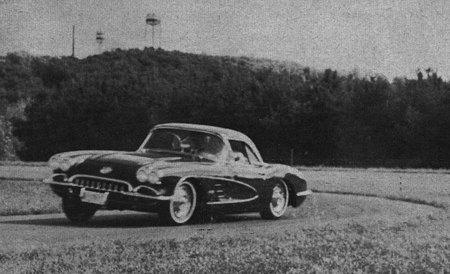Originally published in Sports Car Illustrated in December 1957.
Whether on fast bends or slow, when you reach the limits of adhesion, the back starts to come around in a calm, unhurried manner that leaves you plenty of time to get off the throttle a bit. On a really rough surface, the manner would be rather less unruffled, for the rear axle assembly is a heavy item of unsprung weight. After finishing the tests, we were told that the car we had been driving had not one of the HD suspension options. We were suitably impressed.
The fact that the acceleration times for this car differ somewhat from those of our previous Corvette tests is more likely due to the easy-going driving technique used than anything else. Our test driver, Mr. Rose, who was provided by GM to do the driving while the Technical Editor did the timing, confessed that standing starts were not his specialty. As we have said before, they were not the Corvette’s most polised maneuver either. It is a crying shame that the new “four-link” rear suspension on the regular Chevy’s is not used here, where its ability to completely eliminate axle wind-up would be most appreciated. Parenthetically, this major advance in rear suspension (for American cars, that is) comes about as an incidental result of the switch to air suspension and the attendant loss of a means of location (provided formerly by the leaf springs).
Once under way, the Positraction differential really earns its keep and the acceleration is quite break-taking. The gear ratios in the four speed gearbox (at last!) are marvelously spaced — the ratio step between gears ranges from 1.265 to 1.325 — and all gears are synchronized (will wonders never cease?). It is at least the equal to any gear box we’ve ever tried, not only with respect to the suitability of the ratios to the engine performance, but the smoothness of the synchromesh brings to mind the old metaphor about a hot knife and butter.
One fault which did show up toward the end of our acceleration runs was a trace of clutch slip when rushing the shift. When you consider that for the previous ten days this same car had been subjected to the machinations of various and sundry road-testing “experts” from all sorts of publications, then this is perhaps understandable.
Because our tests were made on a regular working day at the Proving Grounds, the normal “traffic” on the high speed straight (2 1/2 miles of level, three-lane road in each direction with a banked turnaround at each end) prevented the Test Manager, Mr. Caswell, from allowing us to exceed 110 mph. With the same final drive ratio and engine as last year’s F.I. test car, the top speed should be about the same, namely 125 mph, as the frontal aspect is not changed all that much.
As before, the throttle linkage seems a bit quicker than we would prefer, and with the faster bends requiring careful feathering, it is necessary to brace the edge of your right foot against the transmission bulge, pivoting it from there to operate the throttle. The steering wheel, in typical Chevrolet fashion, is right under the driver’s chin. Even so, the Corvette is very easily controlled, the brake and clutch pedals are both well placed and smooth in operation, and there is puh-lenty of room to stretch your left foot — or brace it, on sharp right turns. And brace it you must, because the Corvette’s bucket-style seats are the best argument for seat belts we’ve ever seen. At the risk of repeating last year’s criticisms all over again, you sit on them, not in them, and there is virtually no laterial support whatsoever. Seat belts will be standard equipment this year, which is admirable indeed; but better contoured seats would be another big step ahead, too.
The brakes were so good that we kept up our punishing test for twelve stops instead of the usual ten, and it was only in the last two that a slight but definite weakening showed up. We were therefore quite disappointed to find that these were experimental linings only. Still, it’s encouraging, as it shows that Chevrolet’s been doing a lot of work to provide the average Joe with significantly better brakes, without his being subjected to the drawbacks of the HD kit’s Cerametallics — and with a fair amount of success.
For the price of the Corvette, check with your Chevrolet dealer; GM says they’re all independent businessmen who are free to set their own prices. Especially on the options, we might add. Without quoting any figures, we’d say that on the basis of local (N.Y.) prices the Corvette ranks as a Best Buy, both as a boulevard sports car and as a competition model.


Leave a Reply